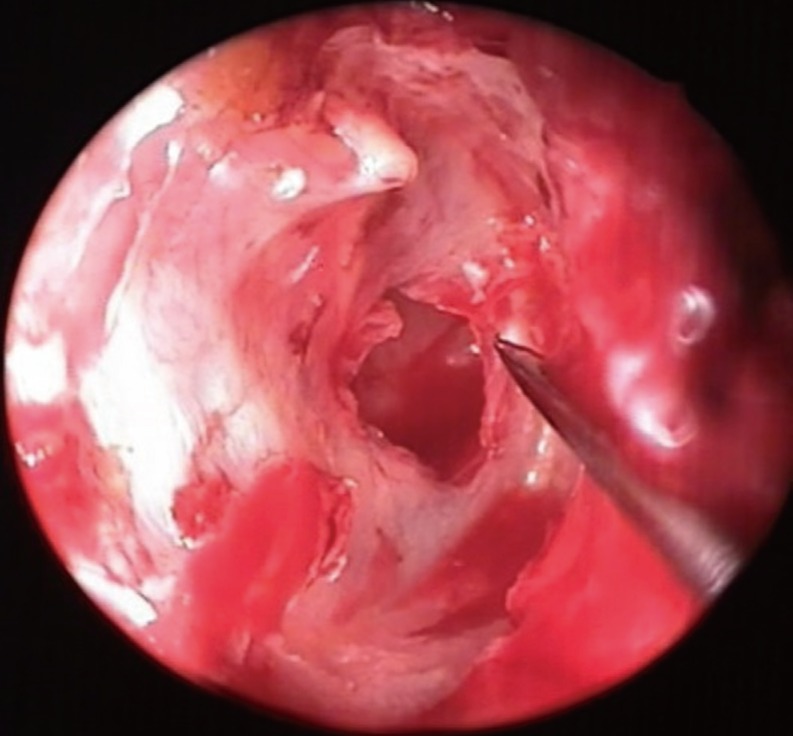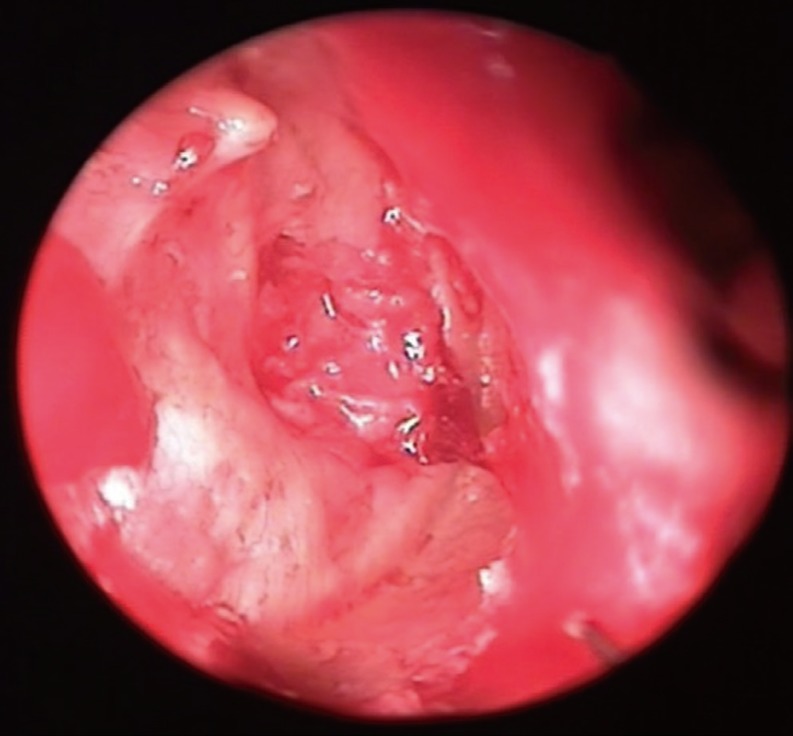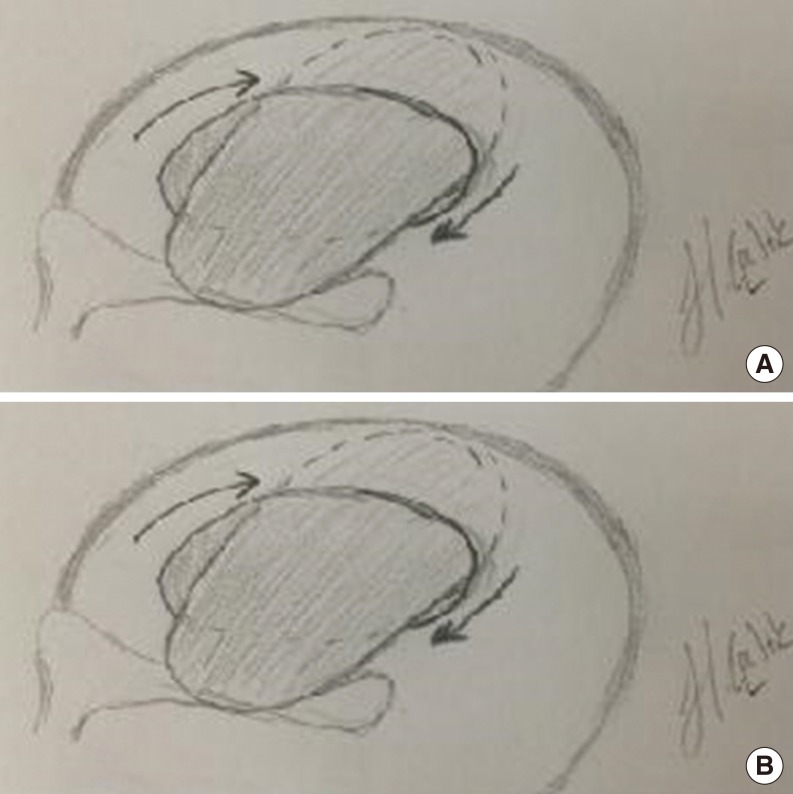Clin Exp Otorhinolaryngol.
2015 Sep;8(3):224-229. 10.3342/ceo.2015.8.3.224.
Endoscopic "Push-Trough" Technique Cartilage Myringoplasty in Anterior Tympanic Membrane Perforations
- Affiliations
-
- 1Otorhinolaryngology Clinic, Ministry of Health Ankara Education and Research Hospital, Ankara, Turkey. haticecelik66@gmail.com
- 2Department of Biostatistics, Ankara University Faculty of Medicine, Ankara, Turkey.
- KMID: 2117516
- DOI: http://doi.org/10.3342/ceo.2015.8.3.224
Abstract
OBJECTIVES
To evaluate endoscopic push-through technique cartilage myringoplasty results.
METHODS
This prospective study was performed on patients with anterior tympanic membrane perforations and endoscopic push-through technique cartilage myringoplasty was performed between 2011 and 2013. The patients who did not have any cholesteatoma or otorrhea in the previous 3 months, and had an air bone gap < or =25 dB in their preoperative audiograms were included in the study. They were followed up with endoscopic examination and audiograms at 2nd, 6th, 12th, and 24th postoperative months. Pure tone averages were calculated at 0.5, 1, 2, and 4 kHz frequencies.
RESULTS
Of 32 patients, 19 were females and 13 were males. The mean age was 40.3 years (range, 16 to 62 years), and the mean follow-up period was 12.4 months (range, 6 to 24 months). Graft success rate was 87.5% in this study. Preoperative mean air conduction hearing threshold was 25.9 dB, and the mean air-bone gap was 11.9 dB while these values improved to 19.5 dB and 5.3 dB respectively in the postoperative period. The mean hearing gain was 6.4 dB. The analysis of preoperative and postoperative mean air conduction thresholds and air bone gap values of the patients revealed statistically significant differences.
CONCLUSION
Underlay cartilage myringoplasty with endoscopic push-through technique in anterior quadrant tympanic membrane perforations is an effective, minimally invasive and feasible method.
Keyword
MeSH Terms
Figure
Cited by 1 articles
-
Safety and Effectiveness of Endoscopic Ear Surgery: Systematic Review
Mi Hye Jeon, Seokang Chung, Seok Hyun Kim, Seung-ha Oh, Gi Jung Im, Jang-Rak Kim, Jinwook Choi, Byung Don Lee
Korean J Otorhinolaryngol-Head Neck Surg. 2019;62(7):367-378. doi: 10.3342/kjorl-hns.2018.00570.
Reference
-
1. Raj A, Meher R. Endoscopic transcanal myringoplasty: a study. Indian J Otolaryngol Head Neck Surg. 2001; 1. 53(1):47–49. PMID: 23119751.2. Yadav SP, Aggarwal N, Julaha M, Goel A. Endoscope-assisted myringoplasty. Singapore Med J. 2009; 5. 50(5):510–512. PMID: 19495522.3. Tarabichi M. Endoscopic middle ear surgery. Ann Otol Rhinol Laryngol. 1999; 1. 108(1):39–46. PMID: 9930539.
Article4. Tarabichi M. Endoscopic transcanal middle ear surgery. Indian J Otolaryngol Head Neck Surg. 2010; 1. 62(1):6–24. PMID: 23120674.
Article5. Yung M. Cartilage tympanoplasty: literature review. J Laryngol Otol. 2008; 7. 122(7):663–672. PMID: 18312709.
Article6. Patil RN. Endoscopic tympanoplasty-definitely advantageous (preliminary repoerts). Asian J Ear Nose Throat. 2003; 25:9–13.7. Dornhoffer JL. Cartilage tympanoplasty. Otolaryngol Clin North Am. 2006; 12. 39(6):1161–1176. PMID: 17097439.
Article8. Buckingham RA. Fascia and perichondrium atrophy in tympanoplasty and recurrent middle ear atelectasis. Ann Otol Rhinol Laryngol. 1992; 9. 101(9):755–758. PMID: 1514753.
Article9. Iacovou E, Vlastarakos PV, Papacharalampous G, Kyrodimos E, Nikolopoulos TP. Is cartilage better than temporalis muscle fascia in type I tympanoplasty? Implications for current surgical practice. Eur Arch Otorhinolaryngol. 2013; 11. 270(11):2803–2813. PMID: 23321796.
Article10. Yung M, Vivekanandan S, Smith P. Randomized study comparing fascia and cartilage grafts in myringoplasty. Ann Otol Rhinol Laryngol. 2011; 8. 120(8):535–541. PMID: 21922978.
Article11. Albirmawy OA. Comparison between cartilage-perichondrium composite 'ring' graft and temporalis fascia in type one tympanoplasty in children. J Laryngol Otol. 2010; 9. 124(9):967–974. PMID: 20403227.
Article12. Couloigner V, Baculard F, El Bakkouri W, Viala P, Francois M, Narcy P, et al. Inlay butterfly cartilage tympanoplasty in children. Otol Neurotol. 2005; 3. 26(2):247–251. PMID: 15793413.
Article13. Denoyelle F, Roger G, Chauvin P, Garabedian EN. Myringoplasty in children: predictive factors of outcome. Laryngoscope. 1999; 1. 109(1):47–51. PMID: 9917039.
Article14. Glasscock ME 3rd, Jackson CG, Nissen AJ, Schwaber MK. Postauricular undersurface tympanic membrane grafting: a follow-up report. Laryngoscope. 1982; 7. 92(7 Pt 1):718–727. PMID: 7087638.
Article15. Vartiainen E, Nuutinen J. Success and pitfalls in myringoplasty: follow-up study of 404 cases. Am J Otol. 1993; 5. 14(3):301–305. PMID: 8372930.16. Zhang H, Wu B, Xu M. A clinical research of endoscopic myringoplasty with modified sandwich technique. Lin Chung Er Bi Yan Hou Tou Jing Wai Ke Za Zhi. 2012; 4. 26(7):293–294. 299PMID: 22737867.17. Ayache S. Cartilaginous myringoplasty: the endoscopic transcanal procedure. Eur Arch Otorhinolaryngol. 2013; 3. 270(3):853–860. PMID: 22639200.
Article18. Nardone M, Sommerville R, Bowman J, Danesi G. Myringoplasty in simple chronic otitis media: critical analysis of long-term results in a 1,000-adult patient series. Otol Neurotol. 2012; 1. 33(1):48–53. PMID: 22143300.19. el-Guindy A. Endoscopic transcanal myringoplasty. J Laryngol Otol. 1992; 6. 106(6):493–495. PMID: 1624881.
Article20. Harugop AS, Mudhol RS, Godhi RA. A comparative study of endoscope assisted myringoplasty and micrsoscope assisted myringoplasty. Indian J Otolaryngol Head Neck Surg. 2008; 12. 60(4):298–302. PMID: 23120569.
Article21. Karhuketo TS, Ilomaki JH, Puhakka HJ. Tympanoscope-assisted myringoplasty. ORL J Otorhinolaryngol Relat Spec. 2001; Nov-Dec. 63(6):353–357. PMID: 11713424.
Article
- Full Text Links
- Actions
-
Cited
- CITED
-
- Close
- Share
- Similar articles
-
- Comparison of Myringoplasty for the Chronic Small Tympanic Membrane Perforations: Fat versus Perichondrium
- Two Cases of Fat Graft Myringoplasty
- The Effect of the Amniotic Membrane on Treatment of Tympanic Membrane Perforation
- Fat Myringoplasty Trimmed with CO2 Laser
- Surgical Outcomes of Pure-Fat Myringoplasty for Small Tympanic Membrane Perforations: A Retrospective Study and Summary of the Literature in the Last 10 Years





